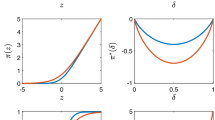Abstract:
Non-equilibrium phenomena occur not only in the physical world, but also in finance. In this work, stochastic relaxational dynamics (together with path integrals) is applied to option pricing theory. Equilibrium in financial markets is defined as the absence of arbitrage, i.e. profits “for nothing”. A recently proposed model (by Ilinski et al.) considers fluctuations around this equilibrium state by introducing a relaxational dynamics with random noise for intermediate deviations called “virtual” arbitrage returns. In this work, the model is incorporated within a martingale pricing method for derivatives on securities (e.g. stocks) in incomplete markets using a mapping to option pricing theory with stochastic interest rates. The arbitrage return is considered as a component of a fictitious short-term interest rate in a virtual world. The influence of intermediate arbitrage returns on the price of derivatives in the real world can be recovered by performing an average over the (non-observable) arbitrage return at the time of pricing. Using a famous result by Merton and with some help from the path integral method, exact pricing formulas for European call and put options under the influence of virtual arbitrage returns (or intermediate deviations from economic equilibrium) are derived where only the final integration over initial arbitrage returns needs to be performed numerically. This result, which has not been given previously and is at variance with results stated by Ilinski et al., is complemented by a discussion of the hedging strategy associated to a derivative, which replicates the final payoff but turns out to be not self-financing in the real world, but self-financing when summed over the derivative's remaining life time. Numerical examples are given which underline the fact that an additional positive risk premium (with respect to the Black-Scholes values) is found reflecting extra hedging costs due to intermediate deviations from economic equilibrium.
Similar content being viewed by others
Author information
Authors and Affiliations
Additional information
Received 16 June 1999 and Received in final form 26 September 1999
Rights and permissions
About this article
Cite this article
Otto, M. Stochastic relaxational dynamics applied to finance: Towards non-equilibrium option pricing theory. Eur. Phys. J. B 14, 383–394 (2000). https://doi.org/10.1007/s100510050143
Issue Date:
DOI: https://doi.org/10.1007/s100510050143



